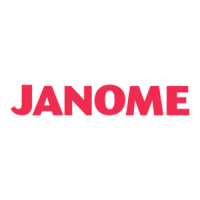JANOME Embroidery Software Instruction Book
Chapter 24 Printing Designs
190
Template Mode: shows the design outline with no
stitches. By default, it includes cloth setter marks to
allow accurate placement of designs within layouts
on the item or fabric to be sewn. See Printing design
layouts for details.
Design Mode: shows the design as it appears in the
Design Window. When you choose this mode,
further choices become available.
Note While the cloth setting marking is supported in
JEF and SEW files, outlines are not. Since JEF and
SEW are stitch file formats, they only contain stitch
data, no outlines. The workaround is to display JEF and
SEW files in Design Mode with stitches and cloth setter
marking turned on.
4 Check Embroidery Elements as required. See
Printing embroidery elements for details.
5 Check Appliqué Patterns if you want a copy of the
appliqué pattern as a template for cutting out fabric
pieces. See Printing appliqué patterns for details.
6 Check Color Layers for a list of colors in the design,
together with color and stitch information for each layer.
See Printing color layers for details.
7 Check Embroidery Information to toggle the display
of embroidery details on/off. In Design mode,
information is removed from the worksheet as it is in
Template mode.
8 Check Cloth Setter Marking as required.
The option applies to both Template and Design
modes. In the latter case, it is only available with
Embroidery Elements and Actual Size selected.
Each hooping will have a number printed near the cloth
setter mark to indicate the hoop stitching sequence.
See Printing design layouts for details.
9 Check Work Area to include an outline of the work
area on the worksheet. See Creating ornamental
layouts for details.
The option applies to both Template and Design
modes.
Try this! When printing a large layout the software will
display a warning dialog if the number of pages needed
for the printout exceeds 10. Use the Fit To Page option
or choose a % of Actual size to reduce the page count.
10 Check the Grid option to include the background grid
on the worksheet.
11 Select a size option from the Size panel.
The option applies to both Template and Design
modes. When selecting Template mode, the Actual
Size option is automatically selected.
12 Click OK.
Printing embroidery elements
If you choose to print embroidery elements, there
are options to include or exclude start/end point
crosshairs, connectors, background color/fabric as
well as the current hoop. Design information
includes author, estimated length of upper thread
per color and total bobbin usage.
To print embroidery elements
1 Open the Print Options dialog. See Setting print
options for details.
Cloth setter marking displayed
Actual Size
Fit to Page

